Abstract
A semiautomated, kinetic-dependent, enzyme-linked immunosorbent assay (K-ELISA) was adapted to detect serum antibodies to Legionella pneumophila. In a comparative study, 158 human serum samples (79 pairs) were tested by K-ELISA and the standard indirect immunofluorescence assay for determination of antibody levels to L. pneumophila serogroup 1. K-ELISA determinations were made by using a serogroup-specific antigen or a preparation (unfractionated antigen) which contained both common antigen and serogroup-specific reactivity. There was good correlation between the immunofluorescence assay and the K-ELISA by using either antigen, although greater correlation was achieved with the unfractionated antigen (coefficients of correlation, 0.894 with unfractionated antigen and 0.841 with serogroup-specific antigen). These results indicate that the K-ELISA is a reliable alternative to the immunofluorescence assay for serologically diagnosing legionellosis.
Full text
PDF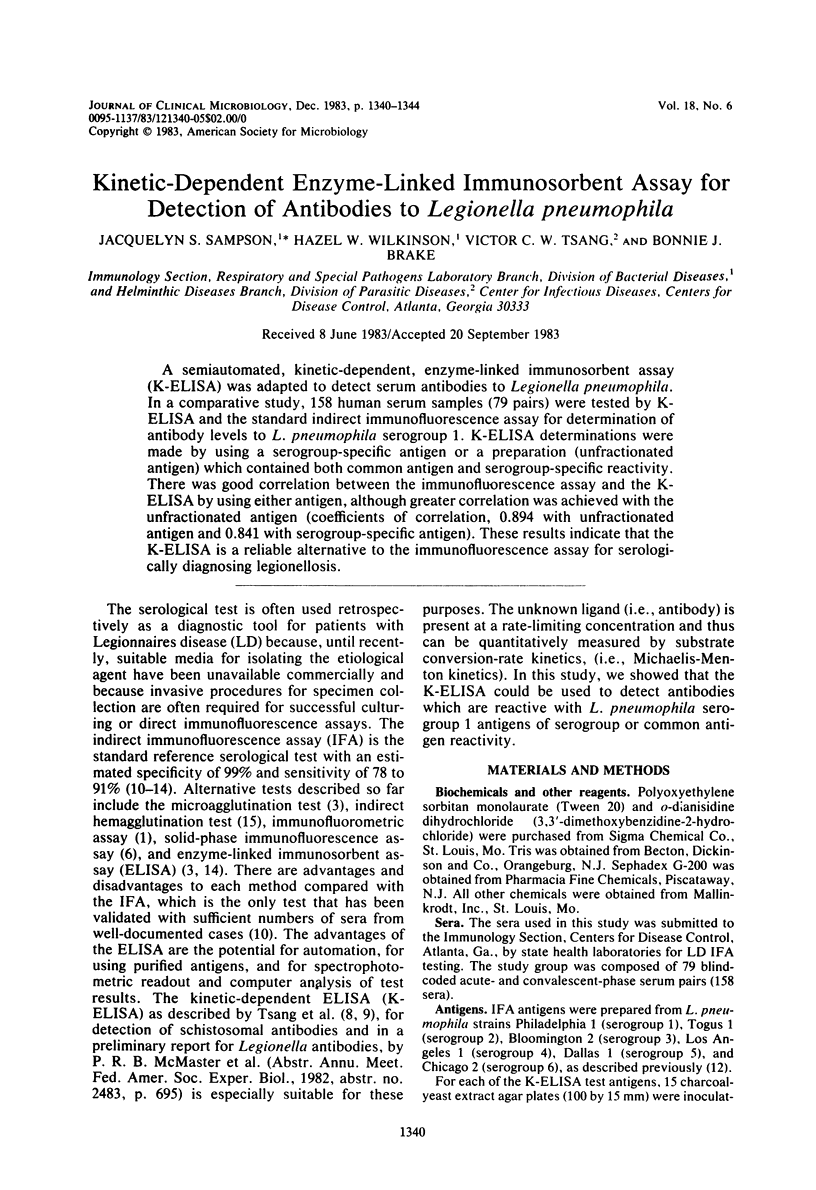
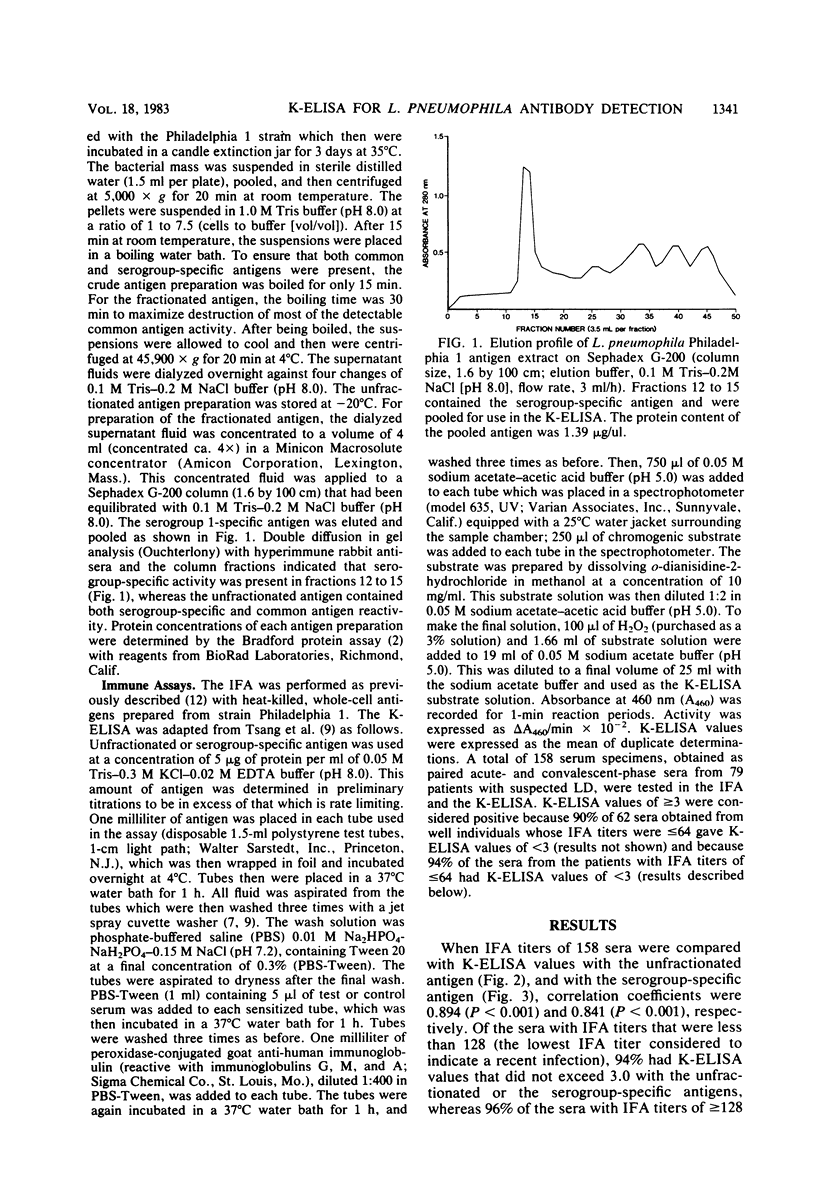
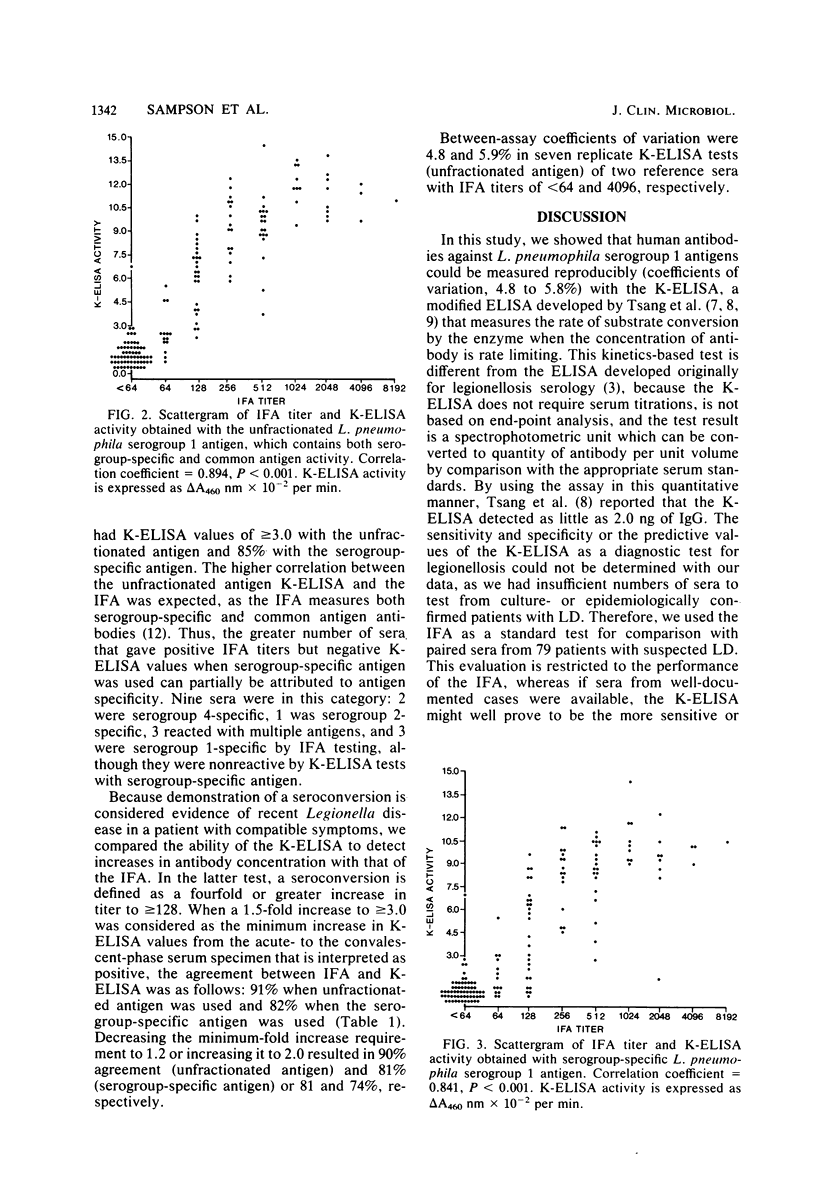
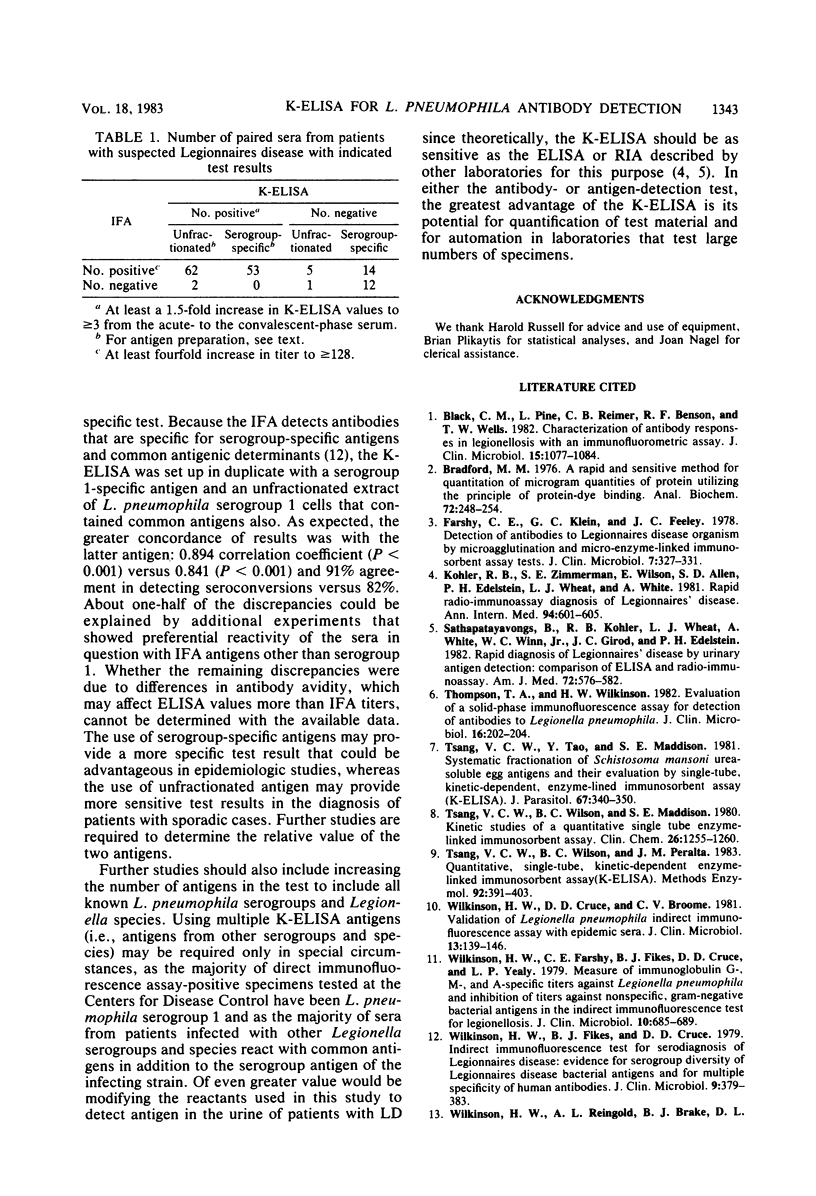
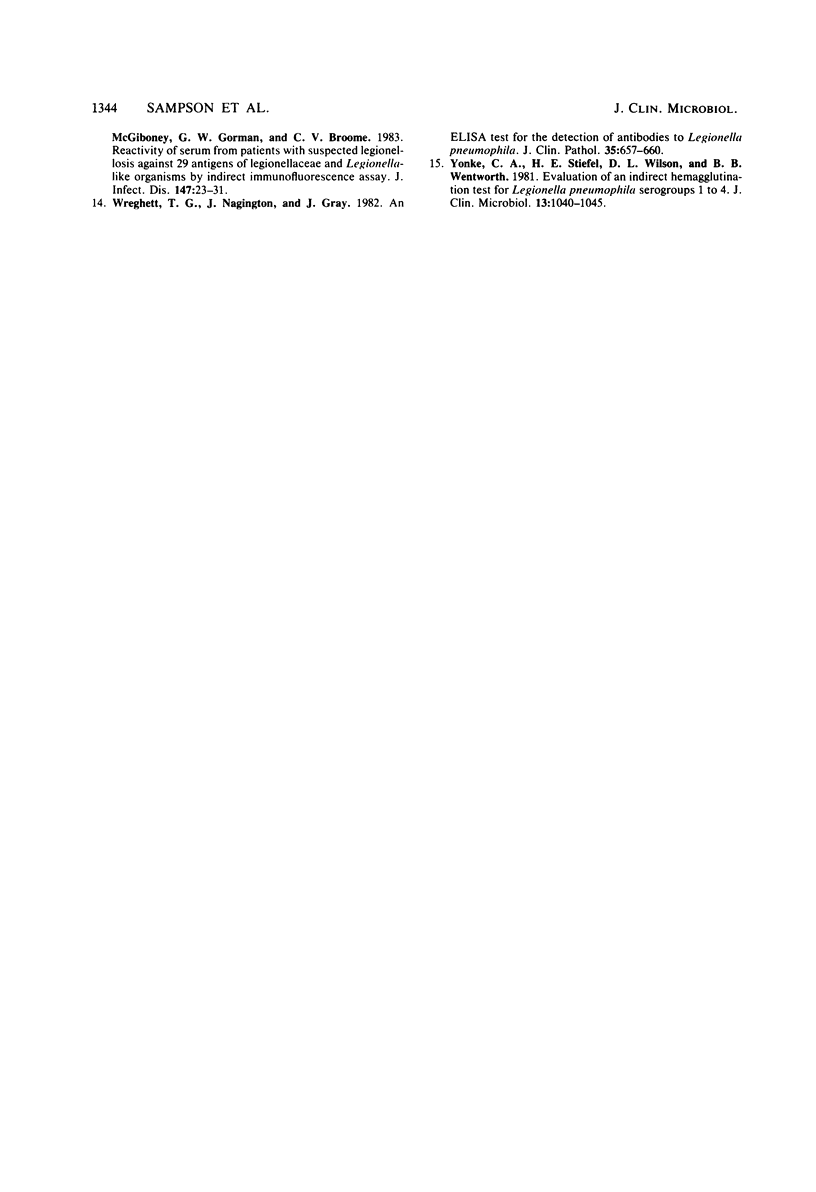
Selected References
These references are in PubMed. This may not be the complete list of references from this article.
- Black C. M., Pine L., Reimer C. B., Benson R. F., Wells T. W. Characterization of antibody responses in legionellosis with an immunofluorometric assay. J Clin Microbiol. 1982 Jun;15(6):1077–1084. doi: 10.1128/jcm.15.6.1077-1084.1982. [DOI] [PMC free article] [PubMed] [Google Scholar]
- Bradford M. M. A rapid and sensitive method for the quantitation of microgram quantities of protein utilizing the principle of protein-dye binding. Anal Biochem. 1976 May 7;72:248–254. doi: 10.1006/abio.1976.9999. [DOI] [PubMed] [Google Scholar]
- Farshy C. E., Klein G. C., Feeley J. C. Detection of antibodies to legionnaires disease organism by microagglutination and micro-enzyme-linked immunosorbent assay tests. J Clin Microbiol. 1978 Apr;7(4):327–331. doi: 10.1128/jcm.7.4.327-331.1978. [DOI] [PMC free article] [PubMed] [Google Scholar]
- Kohler R. B., Zimmerman S. E., Wilson E., Allen S. D., Edelstein P. H., Wheat L. J., White A. Rapid radioimmunoassay diagnosis of Legionnaires' disease: detection and partial characterization of urinary antigen. Ann Intern Med. 1981 May;94(5):601–605. doi: 10.7326/0003-4819-94-5-601. [DOI] [PubMed] [Google Scholar]
- Sathapatayavongs B., Kohler R. B., Wheat L. J., White A., Winn W. C., Jr, Girod J. C., Edelstein P. H. Rapid diagnosis of Legionnaires' disease by urinary antigen detection. Comparison of ELISA and radioimmunoassay. Am J Med. 1982 Apr;72(4):576–582. doi: 10.1016/0002-9343(82)90451-x. [DOI] [PubMed] [Google Scholar]
- Thompson T. A., Wilkinson H. W. Evaluation of a solid-phase immunofluorescence assay for detection of antibodies to Legionella pneumophila. J Clin Microbiol. 1982 Jul;16(1):202–204. doi: 10.1128/jcm.16.1.202-204.1982. [DOI] [PMC free article] [PubMed] [Google Scholar]
- Tsang V. C., Tao Y., Maddison S. E. Systematic fractionation of Schistosoma mansoni urea-soluble egg antigens and their evaluation by the single-tube, kinetic-dependent, enzyme-linked, immunosorbent assay (K-ELISA). J Parasitol. 1981 Jun;67(3):340–350. [PubMed] [Google Scholar]
- Tsang V. C., Wilson B. C., Maddison S. E. Kinetic studies of a quantitative single-tube enzyme-linked immunosorbent assay. Clin Chem. 1980 Aug;26(9):1255–1260. [PubMed] [Google Scholar]
- Tsang V. C., Wilson B. C., Peralta J. M. Quantitative, single-tube, kinetic-dependent enzyme-linked immunosorbent assay (k-ELISA). Methods Enzymol. 1983;92:391–403. doi: 10.1016/0076-6879(83)92033-5. [DOI] [PubMed] [Google Scholar]
- Wilkinson H. W., Cruce D. D., Broome C. V. Validation of Legionella pneumophila indirect immunofluorescence assay with epidemic sera. J Clin Microbiol. 1981 Jan;13(1):139–146. doi: 10.1128/jcm.13.1.139-146.1981. [DOI] [PMC free article] [PubMed] [Google Scholar]
- Wilkinson H. W., Farshy C. E., Fikes B. J., Cruce D. D., Yealy L. P. Measure of immunoglobulin G-, M-, and A-specific titers against Legionella pneumophila and inhibition of titers against nonspecific, gram-negative bacterial antigens in the indirect immunofluorescence test for legionellosis. J Clin Microbiol. 1979 Nov;10(5):685–689. doi: 10.1128/jcm.10.5.685-689.1979. [DOI] [PMC free article] [PubMed] [Google Scholar]
- Wilkinson H. W., Fikes B. J., Cruce D. D. Indirect immunofluorescence test for serodiagnosis of Legionnaires disease: evidence for serogroup diversity of Legionnaires disease bacterial antigens and for multiple specificity of human antibodies. J Clin Microbiol. 1979 Mar;9(3):379–383. doi: 10.1128/jcm.9.3.379-383.1979. [DOI] [PMC free article] [PubMed] [Google Scholar]
- Wilkinson H. W., Reingold A. L., Brake B. J., McGiboney D. L., Gorman G. W., Broome C. V. Reactivity of serum from patients with suspected legionellosis against 29 antigens of legionellaceae and Legionella-like organisms by indirect immunofluorescence assay. J Infect Dis. 1983 Jan;147(1):23–31. doi: 10.1093/infdis/147.1.23. [DOI] [PubMed] [Google Scholar]
- Wreghitt T. G., Nagington J., Gray J. An ELISA test for the detection of antibodies to Legionella pneumophila. J Clin Pathol. 1982 Jun;35(6):657–660. doi: 10.1136/jcp.35.6.657. [DOI] [PMC free article] [PubMed] [Google Scholar]
- Yonke C. A., Stiefel H. E., Wilson D. L., Wentworth B. B. Evaluation of an indirect hemagglutination test for Legionella pneumophila serogroups 1 to 4. J Clin Microbiol. 1981 Jun;13(6):1040–1045. doi: 10.1128/jcm.13.6.1040-1045.1981. [DOI] [PMC free article] [PubMed] [Google Scholar]


